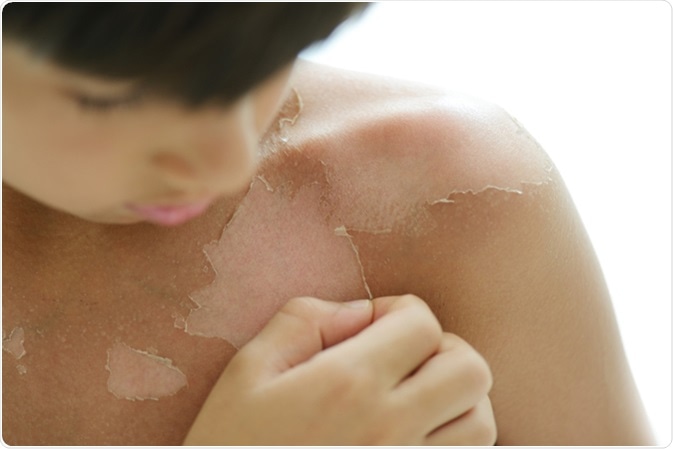For The Latest Medical News, Health News, Research News, COVID-19 News, Pharma News, Glaucoma News, Diabetes News, Herb News, Phytochemical News, Thailand Cannabis News, Cancer News, Doctor News, Thailand Hospital News, Oral Cancer News, Thailand Doctors
Sunburn, or solar erythema, is a short-term skin response to excessive amounts of ultraviolet (UV) radiation, mostly from the sun or from tanning lamps. There are two types of UV rays that are received by the skin during sun exposure, even when it is not during the zenithal times of 10 am to 4 pm; UVA and UVB rays.

UVA radiation has a longer wavelength than UVB and therefore penetrates deeper into the skin, though UVB rays are more powerful. UV rays promote mutations in the DNA of the skin cells and so cause a higher risk of skin cancers such as basal cell and squamous cell carcinomas and melanoma. It is estimated that up to 90% of skin cancers are associated with a history of sunburn or sun exposure.
Intermittent non-zenithal sun exposure and sunburns are most strongly linked with a high melanoma incidence but interestingly, chronic exposure to the sun has failed to show this association. Individuals who have used tanning beds to induce a sun tan, starting from before they were 35 years old, have shown a two-fold risk of developing melanoma. Again, individuals who have left their native temperate climes to migrate to other places with high sunlight or UV exposure have a high risk of melanoma.
Accumulated high sun exposure is linked to basal cell and squamous cell carcinomas, but intermittent exposure is also linked to a higher rate of basal cell tumors. The common factor between the causation of these tumors and melanoma is the history of sunburn. Sunburn in childhood and the use of tanning beds or lamps increased the risk of squamous cell carcinomas, but sunburn at any age was associated with a higher risk of basal cell carcinomas.
The exposure responsible for causing erythema (minimal erythema doses, MED) is about 12 J/cm2 for fair-skinned types. At this range of UV exposure, sunburn cells are found to form, with the accumulation of pyrimidine dimers and nuclear p53. Apoptosis in fibroblasts is increased as well as the number of melanocytes.
While short exposure to zenithal sunlight is more efficient in bringing about these changes, daily UV exposure causes harmful skin effects to accumulate and leading to photodamage to the skin, changes in skin pigmentation both by rearrangement of the melanosomes within the keratinocytes and by induction of melanocyte differentiation. Skin hydration suffers, as does skin elasticity, making the skin look and feel dry, aged and wrinkled. Skin density is reduced.
Epidermal thickness increases by the process of skin hyperplasia, while Langerhans cells are reduced. Free oxygen species are increased, which further damage the lipids and proteins within the skin layers. Dermal architecture is also affected. All these changes do not occur with one exposure at the daily UV radiation level, but cumulative damage produces accelerated skin aging changes. This type of damage occurs at sub-erythema doses repeated over time.
One of the most important findings in these studies is that repeated sunburns, occurring even as rarely as once in 2 years, is linked with a growing risk of skin cancer. For this reason, sun protection using appropriate clothing, and sunscreen with an SPF of 30-40 or above, applied copiously and regularly while outdoors, and avoiding sun exposure during the peak hours, are essential forms of primary prevention of skin cancer. This is especially true if a person has fair skin which burns easily, red hair and blue eyes.
UVB is heavily incriminated (1,000 to 10,000 times more than UVA) in the etiology of sunburn and skin cancer with chronic sun exposure, but less so when it comes to photoaging, which is effectively carried out by UVA as well, though at a level 20-50 times lower.